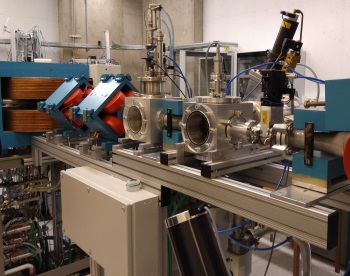Decay correction

In PET studies the concentration of radioactive label of the radioligand (tracer), for example isotope 18F is measured. However, we are interested in concentration of the ligand in tissues (pmol/mL). Measurement of radioactivity is based on observing the emitted gamma rays as the label decays. Ligand itself is not decaying noticeably, since most of the injected ligand does not contain the radioactive isotope label ("cold" ligand); specific activity is decreasing during the PET study. Measured radioactivity concentration must be corrected for the physical decay — only after that the radioactivity concentration is in proportion to ligand mass.
Radioactive decay during PET study can be accounted for either by decay correction of the measured PET data before further analysis, or by implementation of decay into the compartmental model. In TPC the former is preferred, and all data are corrected for the decay to zero time. However, implementation of the decay in the model may allow more precise modelling of the measurement noise and data weighing scheme, possibly leading to less variance in the model parameter of interest (Williams et al., 1995; Glatting and Reske, 1999). An example of a analysis method in which decay is routinely included in the model is the basis functions implementation of the simplified reference tissue model for computation of parametric BPND images.
Halflives of PET isotopes
The literature gives discrepant half-lives (T1/2) for the radioactive isotopes.
Currently the reference used in Turku PET Centre is:
Table of Isotopes, Sixth edition, edited by C.M. Lederer, J.M. Hollander, I. Perlman. WILEY, 1967.
| Isotope | Halflife (sec) | Halflife (min) | Halflife (h) | Halflife (days) |
| C-11 | 1224 | 20.4 | 0.34 | |
| N-13 | 599 | 9.98 | ||
| O-15 | 123 | 2.05 | ||
| F-18 | 6588 | 109.8 | 1.83 | |
| Cu-62 | 582 | 9.7 | ||
| Cu-64 | 45721.1 | 762.018 | 12.7003(1 | |
| Ga-68 | 4080 | 68.0 | 1.13333 | |
| Ge-68 | 2.376E7 | 396000 | 6600 | 275 |
| Br-76 | 58700 | 978 | 16.3 | |
| Rb-82 | 75 | 1.25 | ||
| Zr-89 | 4704 | 78.4 | 3.27 | |
| I-124 | 6013.44 | 100.224 | 4.176 |
1) Reference for the halflife of 64Cu is: Monographie BIPM-5, Table of Radionuclides, Vol. 6, 2011 from BIPM.
Formulas for decay correction
Before correction for physical decay, data must be corrected for detector dead-time and background radioactivity.
The sample radioactivity (At) at the measurement time t can be corrected to the radioactivity at the injection time (A0) using equation:
, where λ (disintegration constant, decay constant) is:
For PET measurements the decay during the frame time must be considered:
, where t1 and t2 are the start and end times of the PET frame; A0 is the decay corrected radioactivity at time zero, and At is the non-corrected radioactivity measured during the PET time frame.
Software for decay correction in TPC
The isotopes, and the corresponding values for halflife and λ, that are identified by most of our in-house software, can be listed with command-line tool halflife.
Decay correction of PET images
Images (in ECAT and Analyze format) can be decay corrected, isotope setting changed, or prior decay correction removed, using program imgdecay.
By default, all PET images are decay corrected to the scan start time. If scan was not started at the injection time, the frame times and decay must be corrected to the true injection time prior to any other calculation with the dynamic image or sinogram; see information on correcting delayed scans.
However, if PET scanning was performed in separate sessions, follow this link: Catenation of PET images or sinograms.
Decay correction of TACs
For plasma/blood and regional PET TACs the decay correction, or removal of decay correction, can be done using program tacdecay.
If PET scan was not started at the injection time but later, and if the
dynamic image was not corrected for this (see above), then the times and
physical decay of radioactivity concentrations in TAC file can be corrected
using program tactime with option -decay.
If PET scanning was performed in separate sessions, and the dynamic images
were not joined together (see above), the separate TAC files can still be joined
together: first you must correct the times and radioactivity concentrations in
the late imaging TAC file(s) using program tactime with
option -decay, and then catenate the TAC files using taccat.
If dynamic PET images are available, the time difference required by program tactime
can be retrieved using program egetstrt.
Ex vivo data
When the injection time and sample measurement times have been recorded, the decay correction factor for a single sample can be computed using dcftime. Of course, the equations above can as well be used to decay correct the data in spreadsheet software.
See also:
- PET data
- Quantification of radioactivity
- Branching factor
- Copper in PET studies
- [68Ga]Ga3+
- Iodine in PET studies,
- Zirconium in PET studies
- Delay correction
Literature
Table of Radionuclides, Monographie BIPM-5, www.bipm.org.
Table of Isotopes, Sixth edition, edited by C.M. Lederer, J.M. Hollander, I. Perlman. WILEY, 1967.
Tags: Radioactivity, Decay correction, Isotope, Time frame
Updated at: 2022-12-15
Written by: Vesa Oikonen, Tuula Tolvanen